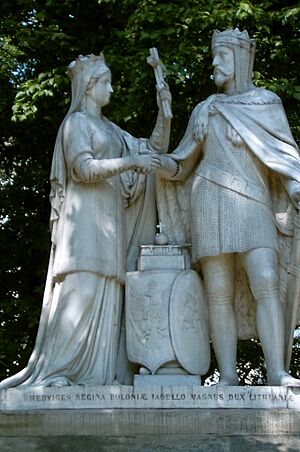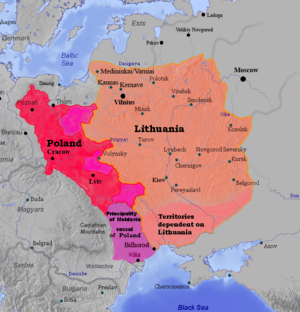Union of Krewo facts for kids
The Union of Krewo was an important agreement made on August 14, 1385. It was a set of promises made by Jogaila, the Grand Duke of Lithuania. He made these promises so he could marry the young Queen Jadwiga of Poland. The agreement happened at Kreva Castle.
Even though the original document was short, the "Union of Krewo" often refers to all the big events that happened between 1385 and 1386. After the agreement, Jogaila became a Christian. He then married Jadwiga and was crowned King of Poland in 1386.
This union was a huge moment for the histories of Poland and Lithuania. It started over 400 years of shared history between the two countries. By 1569, this union grew into a new state called the Polish–Lithuanian Commonwealth. This powerful state lasted until 1795.
Contents
Why the Union Happened
Poland's Situation: Finding a King
In 1382, King Louis I of Hungary died. He only had two daughters, Mary and Jadwiga. This caused a big problem for Poland because they needed a new ruler. Many people wanted the throne.
The Polish nobles did not want to be ruled by Mary's fiancé, Sigismund of Luxembourg. They didn't want Poland to stay connected to Hungary. After many talks, Jadwiga came to Kraków. On October 15, 1384, she was crowned as the King of Poland. She was called "King" to show she had full rights to rule.
Jadwiga still needed a husband. She was supposed to marry William of Austria. He even came to Poland to try and marry her. But Polish nobles forced him to leave. Nobles from southern Poland then suggested that Jadwiga marry Jogaila, the Grand Duke of Lithuania.
Lithuania's Situation: Choosing a Religion
When Grand Duke Algirdas died in 1377, his son Jogaila took over. He ruled a very large country. Many people in Lithuania followed old pagan beliefs, while others were Orthodox Christians. For a long time, Lithuanians had to fight the Teutonic Knights. These Knights were a religious military group who wanted to force Lithuania to become Catholic.
Jogaila knew that Lithuania would eventually have to become Christian. He looked for the best way to do this. In 1382, he made a treaty with the Teutonic Knights. It said he would become Christian within four years. But this treaty was never fully agreed upon. Becoming Christian through an old enemy like the Knights was dangerous. It could make Lithuania dependent on them.
In 1384, Jogaila thought about another option. His mother, Uliana of Tver, suggested he become Orthodox Christian and marry a Russian princess. But for Catholics, being Orthodox was not much better than being pagan. So, this would not stop the Teutonic attacks. The third option, from the Polish nobles, seemed to be the best choice. It avoided the problems of the Knights or Moscow.
The Agreement: Union of Krewo
How the Talks Happened

Poland and Lithuania hadn't always been friends. They had fought wars against each other. But they also saw chances to get back lands they had lost. They both saw the Teutonic Knights as a common enemy.
It's not clear who first suggested Jogaila marry Jadwiga. But talks might have started as early as 1383. For example, Jogaila attacked another duke who wanted the Polish throne. By the time Lithuanian messengers went to Jadwiga's coronation in 1384, Jogaila's idea of marrying her was well known.
In mid-1385, Jogaila sent an official group to Poland. This group included his brother Skirgaila and a merchant named Hanul of Riga. Hanul thought there could be great trade between Poland and Lithuania. The Lithuanian group first met Polish nobles in Kraków. Then they met Queen Elizabeth, Jadwiga's mother, in Hungary. A Polish group then went to Lithuania. When the Lithuanian group returned, Jogaila wrote down all the promises he had made. This written document is what we call the Union of Krewo.
What the Document Said
The document was about 560 words long. It was sent to Queen Elizabeth and the Polish group. Jogaila briefly explained why his group had visited Poland. In exchange for marrying Jadwiga, he agreed to several things:
- Making Lithuania Christian: Jogaila, the Lithuanian nobles, and all pagan Lithuanians would become Roman Catholic.
- Paying Money: He would pay 200,000 florins to William, Duke of Austria. This was because Jadwiga's engagement to William was being ended.
- Returning Lands: He would give back all lands Poland had lost in wars. This especially meant lands in Red Ruthenia that Hungary had taken.
- Freeing Prisoners: He would release all 40,000 or 45,000 Christian war prisoners held by Lithuanians.
- Joining Lands: He would connect Lithuanian and Ruthenian lands to the Crown of Poland. The Latin word used was applicare.
Jogaila's brothers and cousin confirmed these promises with their seals. Because the document only contained promises from Jogaila, some historians believe there must have been another document to finalize the agreement.
After the Union
Marriage and Lithuania Becomes Christian
On January 11, 1386, a Polish group met Jogaila. They told him that Polish nobles agreed to choose him as their new king. He was officially elected on February 1 in Lublin. On February 12, Jogaila and his family arrived in Kraków. Three days later, they were baptized in the Wawel Cathedral. Jogaila's new Christian name was Wladislaus, chosen to honor Jadwiga's great-grandfather, King Władysław I the Elbow-high.
Jogaila married Jadwiga on February 18. On March 4, he was crowned King of Poland. He ruled "by right of his wife." At first, the Pope did not fully approve the marriage because of bad rumors. But a later Pope, Boniface IX, declared it legitimate.
Soon after the marriage, Jadwiga and Vytautas (Jogaila's cousin) went to Galicia. They defeated Hungarian forces and gained a large area of land. Jogaila's older brother, Andrei, tried to take over Lithuania while Jogaila was away. But this rebellion was quickly stopped.
At the end of 1386, Jogaila returned to Vilnius. He wanted to keep his promise to make Lithuania Catholic. He brought priests, started the first seven churches, and even translated important prayers into the Lithuanian language. Many people were baptized quickly. On February 17, 1387, Jogaila ordered the building of the Vilnius Cathedral. He also asked the Pope to create the Diocese of Vilnius. He gave land to this new church.
Two other important laws were made in February and March 1387. These laws gave new rights to nobles who became Christian. They also gave Magdeburg rights to Vilnius, which helped the city grow. These changes encouraged people to convert and made the rights of nobles in Lithuania similar to those in Poland.
The Polish–Lithuanian Union Develops
Jogaila left his brother Skirgaila to rule Lithuania for him. But Skirgaila was not popular. Lithuanian nobles didn't like the growing Polish influence. Vytautas saw this as a chance to gain power, and a civil war started. This war ended with the Ostrów Agreement. Vytautas became the Grand Duke of Lithuania, but Jogaila still had some authority over him. Vytautas managed Lithuania's internal and foreign affairs on his own, but he worked with Jogaila.
A famous example of their cooperation was the big victory against the Teutonic Knights in the Battle of Grunwald in 1410. The relationship between Poland and Lithuania, and Vytautas's independence, were made official by later agreements like the Union of Vilnius and Radom (1401) and the Union of Horodło (1413). This meant that Lithuania kept its own government.
It was only in 1569, with the Union of Lublin, that Poland and Lithuania truly became one federal state, the Polish–Lithuanian Commonwealth. This state lasted for a long time. Later, in 1791, a new constitution declared them one country. But soon after, they were separated again. For most of the 1800s, both countries were under Russian rule, though they were managed separately. In the early 1900s, both Poland and Lithuania became independent countries again. They have not been formally united since then.
Images for kids



